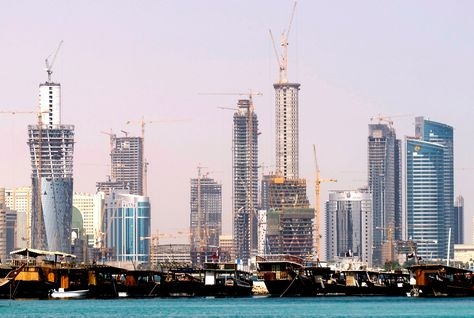Qatar plans to invest about $130 billion in its non-hydrocarbon sector in 2012-2018, the General Secretariat for Development Planning (GSDP) said. Infrastructure spending should average more than 10 per cent of the Opec member's gross domestic product in coming years, the GSDP also said in a statement.
Meanwhile, Qatar expects its economic growth will slow to 4.5 per cent in 2013, the weakest rate in a decade, GSDP said.
OPEC member Qatar's oil and gas-reliant economy has been surging at a break-neck, double-digit pace for the past six years as the country has become the world's largest exporter of liquefied natural gas, but it is expected to decelerate as the impact of two decades of gas output expansion fades.
The GSDP sees inflation-adjusted gross domestic product growth easing to 6.2 per cent in 2012 from 14.0 per cent last year. The weakening global growth outlook and the euro zone debt crisis pose a risk to Qatar as they are affecting oil prices.
"While the (euro) bloc's problems may seem remote from Qatar, an unexpected weakening of oil prices risks reducing the resources available to the state," the GSDP said.
Worsening global economy prospects have already knocked crude oil prices down $35 from March highs to around $90 per barrel, near the lowest levels since December 2010.
The International Monetary Fund said in January, after concluding regular consultations with Qatar, that its government had adequate financial cushions to mitigate potential risks.
"4.5 per cent is a bit below our expectations, but is still a fairly healthy number," said Paul Gamble, head of research at Jadwa Investment in Riyadh.
Qatar, which has avoided the social unrest that rocked the Arab world last year, plans to boost government spending by 27 per cent to $49 billion in the fiscal year that began in April.
It plans to invest about $130 billion in its non-hydrocarbon sector in 2012-2018, the GSDP said. Infrastructure spending should average more than 10 per cent of GDP ahead of the 2022 soccer World Cup.
"We anticipate robust activity in the construction sector, primed by Qatar's infrastructure spending plans. This is likely to peak around 2015, so we are still very much in the development phase," Frank Harrigan, director of the GSDP's Economic Development department, told a news conference.
"Over the longer term, there are opportunities in the downstream hydrocarbon sector, but these investments are still very much in the planning stage. By 2020 we will see a more significant presence in downstream petrochemical projects than today."
In September, Qatar raised basic salaries and social benefits for state civilian employees by 60 per cent, while military staff received 50-120 per cent increases.
Despite increased spending, the Gulf Arab country's government budget should show a comfortable surplus of 7.8 per cent of GDP in the 2012 calendar year, although GSDP forecasts it to fall to 4.8 per cent in 2013.
Inflation in Qatar, which pegs its riyal to the U.S. dollar, should edge higher and float between 2 and 3 per cent in 2012 and 2013, the GSDP said. It has been hovering just above 1 per cent since the start of 2012 due to weakness in the property sector.
"Inflationary pressures are expected to remain tame in 2012 and 2013," the GSDP said.
"Excess supply in the residential rental market looks set to continue and – in a context of anemic global demand – non-fuel global commodity prices seem unlikely to stoke imported inflation," it said.
Only 250,000 of Qatar's 1.7 million population are Qatar citizens, the rest being foreign workers and professionals.
Construction ahead of the 2022 World Cup is likely to boost the number of low-skilled workers from the Indian sub-continent, but as they remit much of their income overseas the increase in their numbers is unlikely to create inflation pressure.
"The pressures they will create on the economy will be very different than that of a professional workforce. We don't see acute inflationary pressures arising from this source," Harrigan said.
Reuters
25 Jun






















































